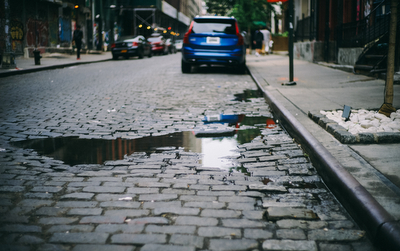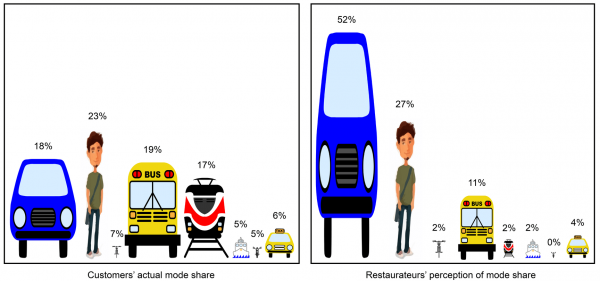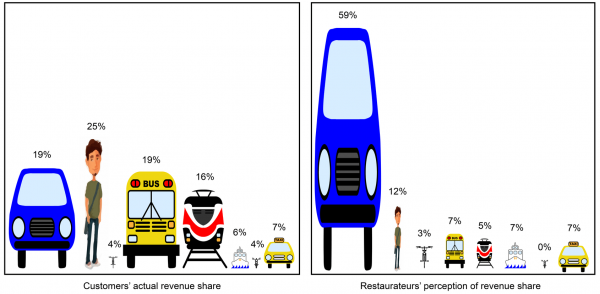
Location is a crucial competitive aspect for retailers in general and restaurants in particular. Once the location is chosen, there are limited options to improve access to their business. Therefore, they usually tend to advocate for increasing parking supply as a way of providing more convenience to their current and potential customers and as such, abundant parking is perceived as vital for their business success. However, it is not always what clients want and not necessarily the right solution for increasing revenue.
As reported by The Conversation, research was conducted in three restaurant precincts in Brisbane focused on verifying if car parking is as important as restaurateurs believe. To understand that, customers’ mode of transportation to travel to the restaurant and their spend were investigated as well as restaurateurs’ perception on both aspects.
As can be seen in the graphs below, there are significant differences between restaurateurs’ perceptions and the actual consumer behaviour. The largest gap is related to car usage, while restaurateurs believe that 52% of their customers use this mode of transport, the reality is that it only represents 18%. On the other hand, the mode share of public transportation is underestimated by restaurateurs; they thought that only 15% of their clients travelled by public transport when in fact 41% of them do.

In addition, restaurateurs also have a misperception of the revenue share of customers according to their mode of transport. The graphs below demonstrate that gap:

The study indicates that consumers who walked, cycled or used public transport to travel to restaurants spent more than those who used cars. Researchers conducted two simulations to evaluate potential impacts of these findings on the restaurant’s revenue.
The first one increased the number of consumers who travelled to the precinct by car to 52% by reducing their travel costs by 30% (to $ 2.896 per person) while limiting the number of consumers per day to 300. The result was a 2% decrease in revenue because this change would result in a reduction of higher-spending consumers who travel by other modes.
The second simulation proposed reducing public transport costs by $2.89, applying similar conditions as the previous test; the result indicates a 3% increase in total revenue. Therefore, this analysis suggests that restaurateurs at those particular precincts should be advocating for improvements to attract more consumers who travel by public transport, bicycle or walk, instead of increasing parking supply.
Our post No parking, no business? discussed a similar study which presented the misperception of Toronto’s merchants regarding the travelling mode of their clients. In that case, local businesses’ best clients were those arriving by active transportation (walking or cycling) as they spent more and visited the area more frequently than the others.
For further information read the article What’s the impact of reducing parking spaces? and check the infographic Fact vs. Fiction parking control kills the retail strip.
Image source: Josh Wilburne and The Conversation

One Response
Interesting piece! I wonder if it’s possible to dive deeper into the actual revenue categories. I bet that alcohol is one of the primary factors that bring more money from non-car travelers. Also, are there any other environmental factors in the analysis, such as proximity of metro station or bus stop, bike parking, etc.?